APAC Organic Baby Food Market Size
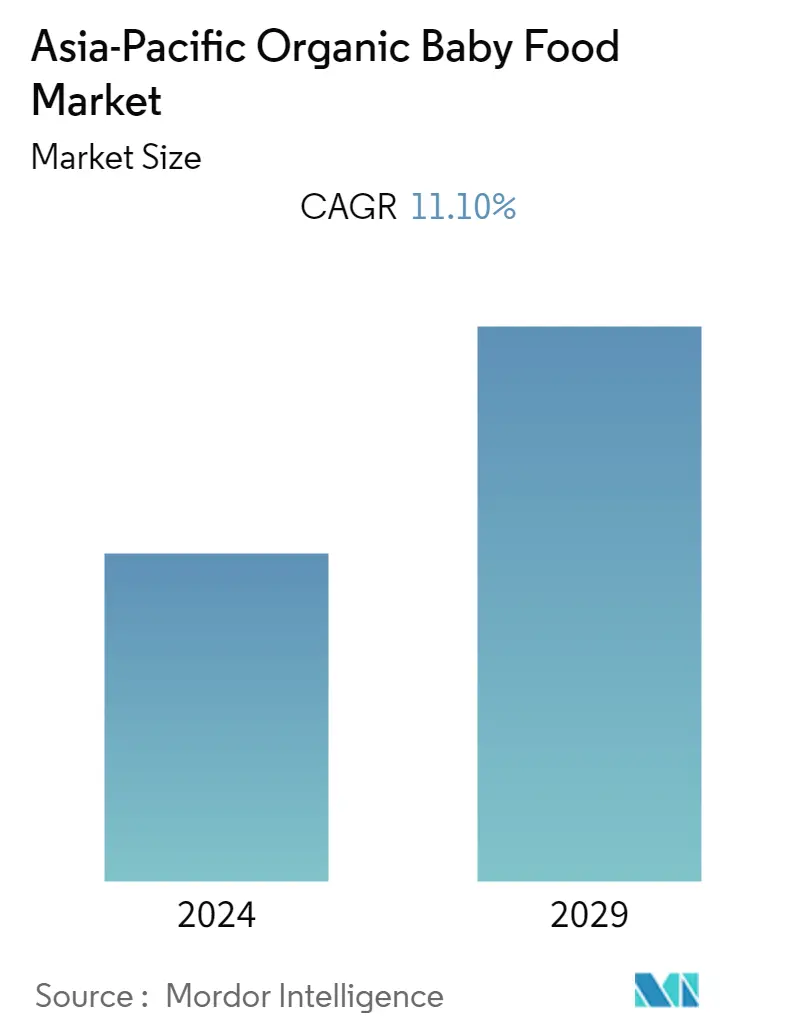
| Study Period | 2019 - 2029 |
| Base Year For Estimation | 2023 |
| Forecast Data Period | 2024 - 2029 |
| Historical Data Period | 2019 - 2022 |
| CAGR | 11.10 % |
| Market Concentration | Low |
Major Players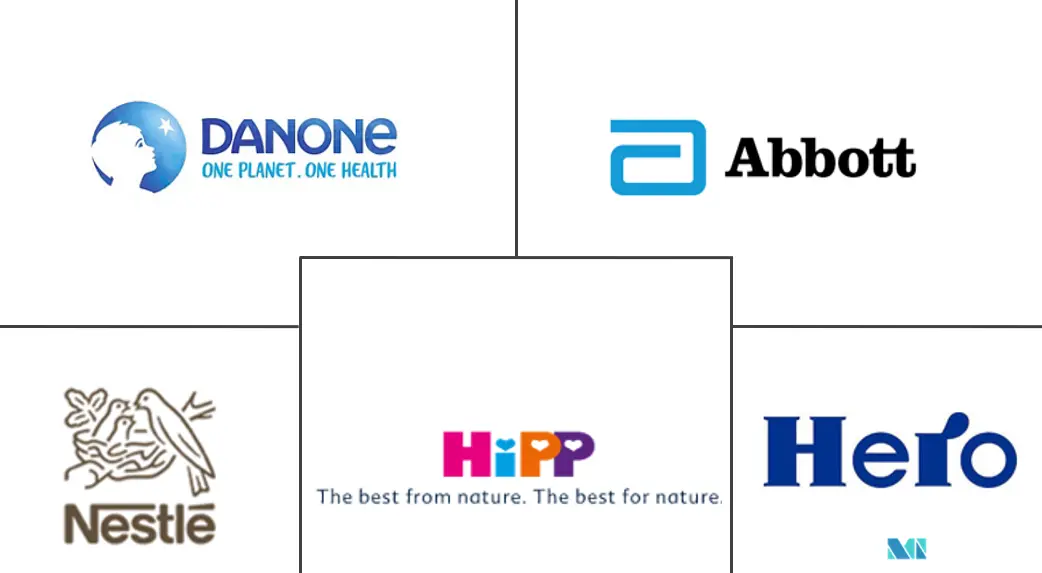
*Disclaimer: Major Players sorted in no particular order |
Need a report that reflects how COVID-19 has impacted this market and its growth?
APAC Organic Baby Food Market Analysis
The Asia-Pacific organic baby food market is projected to register a CAGR of 11.1% during the forecast period.
The growing awareness of the harmful effects of synthetic ingredients present in baby foods and the authenticity associated with organic baby food is driving consumers to switch to organic baby food as it is free of chemicals. The increased concern about the prevalence of lifestyle diseases is a major factor contributing to the growth of organic baby foods.
Over the long term, the baby food market is estimated to expand as parents seek healthy and nutritious ready-to-eat food options for their babies. The availability of a diverse product range for various flavors and innovations in baby food is estimated to drive the Asia-Pacific organic baby food market. Moreover, manufacturers are producing snacks that are suitable for infants at the teathing stage and introducing food textures and tastes, which is boosting the growth of the market.
Organic baby foods are considered premium products in the region. The high price of organic baby foods due to the high cost of organic raw materials is restraining the growth of the market in the region, as only high-income groups can afford organic baby foods. However, the willingness of parents to pay for healthy food is increasing the sales of organic baby foods.
APAC Organic Baby Food Market Trends
This section covers the major market trends shaping the APAC Organic Baby Food Market according to our research experts:
Resistance toward Conventional Baby Foods
The increased spraying of pesticides and other chemicals to improve the yield of products is deteriorating the overall quality of the food product. With consumer knowledge of the health consequences associated with pesticides, insecticides, and other chemical residues found in food, there is an increase in demand for natural and organic foods. According to FAO, In 2020, China was the largest insecticide-consuming country worldwide at 70 thousand metric tons. With the high use of chemicals, consumers are more inclined toward products that have clean labels and contain a lower level of synthetic ingredients to ensure food safety.
Moreover, the sustainability concerns of the parents have led manufacturers to develop carbon-neutral organic products. For instance, in July 2022, Nestle SA launched its first carbon-neutral toddler formula, a stage three formula for toddlers said to be sourced from Switzerland-based farms that do not use herbicides and growth hormones. The product is offered for toddlers of age 12-36 months and was launched online in China.
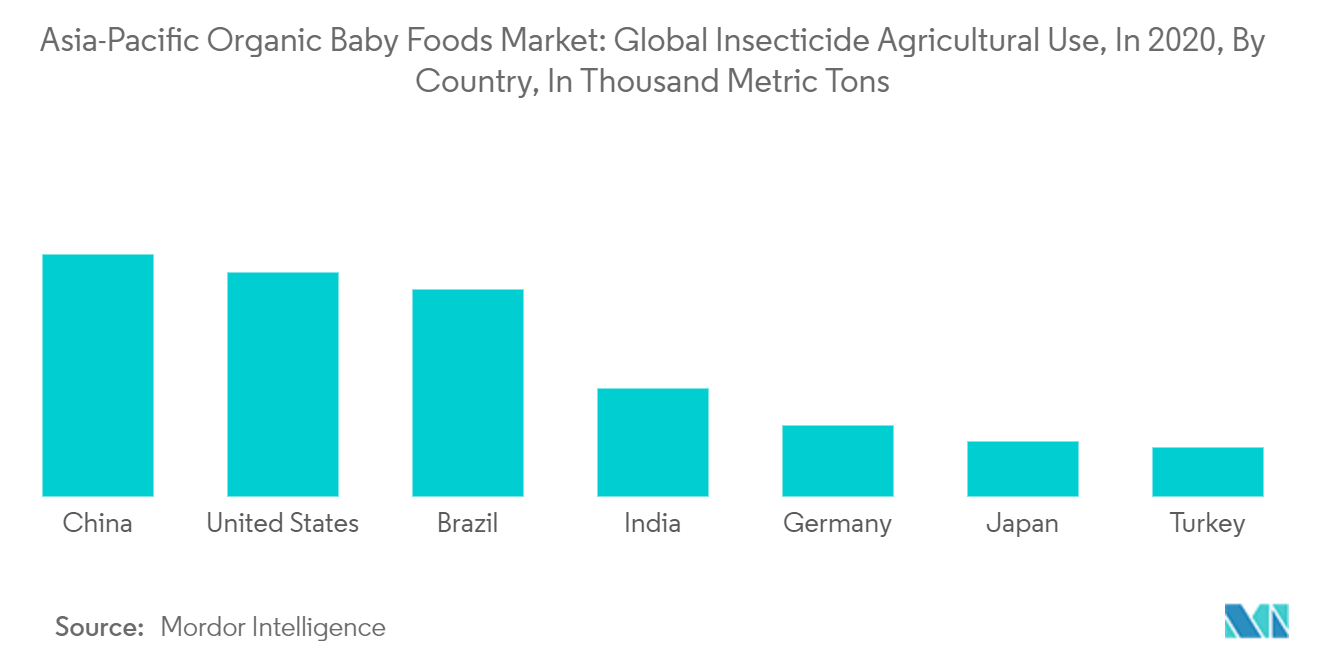
Milk Formulas hold a Significant Share
Parents are now choosing food for their babies more carefully. They look for ones that are free of chemicals, artificial ingredients, additives, added flavors, etc. The presence and availability of organic baby food and its closeness to breast milk are some of the driving factors for organic milk powders. The rising organic infant formula market relies on suboptimal breastfeeding rates, the substituting of breast milk at the early stage, and increased fertility rates.
China holds a significant market share of the Asia-Pacific organic baby food market. The increasing population, rise in working women and hectic work schedules, and insufficient breast milk is driving the sales of organic baby foods. Consumers in China are focusing on baby food with immunity-boosting ingredients. For instance, in August 2022, China's Junlebao Dairy Group launched a new infant formula that mimics breast milk. The company claims that it contains one of the highest lactoferrin content in the market to meet the demand of parents looking for immune health benefits.
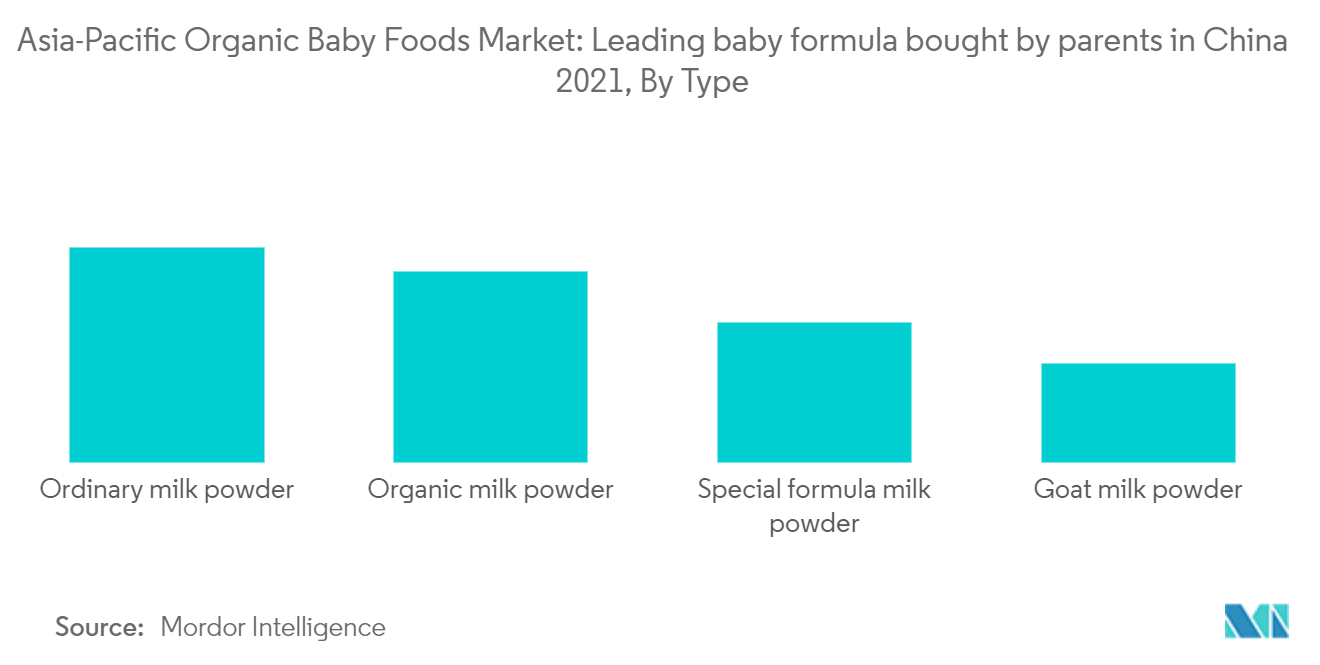
APAC Organic Baby Food Industry Overview
The Asia-Pacific organic baby food market is highly competitive owing to the presence of multiple regional and multinational companies offering a wide range of organic baby foods and trying to maintain their leadership position in the market studied.
Major players in the market include Abbott Laboratories, Nestle SA, The Hein Celestial Group, and Danone SA, holding a significant share of the market studied and embarking on business strategies, including product innovations, partnerships, strengthening their hold over online and offline marketing, and mergers and acquisitions, to expand their visibility and portfolio of offerings, thus, augmenting the growth of the market. For instance, in September 2021, HiPP, the largest processor of organic-biological raw materials worldwide, launched a new infant formula packaging featuring a customized version of Aptar Food + Beverage's Neo closure. The neo-closure features an audible click that confirms the product is fully closed after use and also reduces the risk of contamination.
APAC Organic Baby Food Market Leaders
Nestle SA
Hero Group
Abbott Laboratories
Danone SA
Hipp Gmbh & Co.
*Disclaimer: Major Players sorted in no particular order
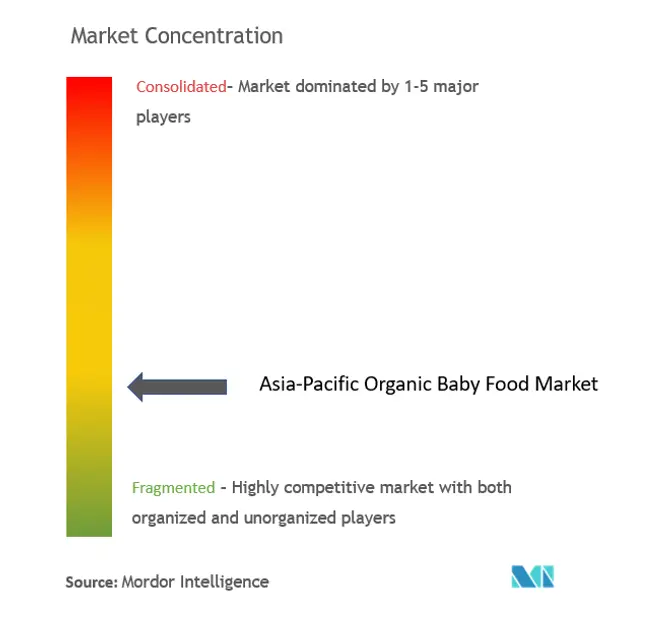
APAC Organic Baby Food Market News
August 2021: Australian pharma and nutraceutical company Max Biocare expanded its baby food brand Little Etoile with a new infant and toddler formula range. The products under the brand Little Etoile are organic.
May 2021: Nestlé set up production for pouched baby-food products in China at the factory in Laixi in the Shandong province. The company started the production of organic puree products sold in China under its international baby-food brand Gerber.
January 2021: Timios, a Bangalore-based packaged healthy snack brand for children, entered the baby food market with the launch of its new category of 'Made to Order Porridge' range for infants and toddlers. This new product is organically certified and is available in 12 variants.
APAC Organic Baby Food Market Report - Table of Contents
1. INTRODUCTION
1.1 Study Assumptions and Market Definition
1.2 Scope of the Study
2. RESEARCH METHODOLOGY
3. EXECUTIVE SUMMARY
4. MARKET DYNAMICS
4.1 Market Drivers
4.2 Market Restraints
4.3 Porter's Five Forces Analysis
4.3.1 Threat of New Entrants
4.3.2 Bargaining Power of Buyers/Consumers
4.3.3 Bargaining Power of Suppliers
4.3.4 Threat of Substitute Products
4.3.5 Intensity of Competitive Rivalry
5. MARKET SEGMENTATION
5.1 By Product Type
5.1.1 Milk Formula
5.1.2 Prepared Baby Food
5.1.3 Dried Baby Food
5.1.4 Other Product Types
5.2 By Distribution Channel
5.2.1 Supermarkets/Hypermarkets
5.2.2 Convenience Stores
5.2.3 Online
5.2.4 Other Distribution Channels
5.3 By Geography
5.3.1 China
5.3.2 Japan
5.3.3 India
5.3.4 Australia
5.3.5 Rest of Asia-Pacific
6. COMPETITIVE LANDSCAPE
6.1 Most Adopted Strategies
6.2 Market Share Analysis
6.3 Company Profiles
6.3.1 Nestle SA
6.3.2 Hero Group
6.3.3 Campbell Soup Company (Plum Organics)
6.3.4 Abbott Laboratories
6.3.5 Danone SA
6.3.6 Hipp Gmbh & Co.
6.3.7 Amara Organic Foods
6.3.8 Health and Happiness (H & H) International Holding Limited
6.3.9 Bellamy's Australia Limited
6.3.10 Nascens Enterprises Private Limited (Happa Foods)
- *List Not Exhaustive
7. MARKET OPPORTUNITIES AND FUTURE TRENDS
8. IMPACT OF COVID-19 ON THE MARKET
9. DISCLAIMER
APAC Organic Baby Food Industry Segmentation
Organic baby food is baby food processed using ingredients that are grown without the use of synthetic fertilizers or pesticides. The organic baby food market is segmented by product type, distribution channel, and geography. By product type, the segmentation includes prepared baby food, dried baby food, milk formula, and other product types. By distribution channel, the market is segmented into supermarkets/hypermarkets, convenience stores, online retail stores, and other distribution channels. By geography, the market is segmented into China, India, Japan, Australia, and the Rest of Asia-Pacific. For each segment, the market sizing and forecasts are done in value (USD million).
| By Product Type | |
| Milk Formula | |
| Prepared Baby Food | |
| Dried Baby Food | |
| Other Product Types |
| By Distribution Channel | |
| Supermarkets/Hypermarkets | |
| Convenience Stores | |
| Online | |
| Other Distribution Channels |
| By Geography | |
| China | |
| Japan | |
| India | |
| Australia | |
| Rest of Asia-Pacific |
APAC Organic Baby Food Market Research FAQs
What is the current Asia-Pacific Organic Baby Food Market size?
The Asia-Pacific Organic Baby Food Market is projected to register a CAGR of 11.10% during the forecast period (2024-2029)
Who are the key players in Asia-Pacific Organic Baby Food Market?
Nestle SA, Hero Group, Abbott Laboratories, Danone SA and Hipp Gmbh & Co. are the major companies operating in the Asia-Pacific Organic Baby Food Market.
What years does this Asia-Pacific Organic Baby Food Market cover?
The report covers the Asia-Pacific Organic Baby Food Market historical market size for years: 2019, 2020, 2021, 2022 and 2023. The report also forecasts the Asia-Pacific Organic Baby Food Market size for years: 2024, 2025, 2026, 2027, 2028 and 2029.
Asia-Pacific Organic Baby Food Industry Report
Statistics for the 2024 Asia-Pacific Organic Baby Food market share, size and revenue growth rate, created by Mordor Intelligence™ Industry Reports. Asia-Pacific Organic Baby Food analysis includes a market forecast outlook to 2029 and historical overview. Get a sample of this industry analysis as a free report PDF download.
